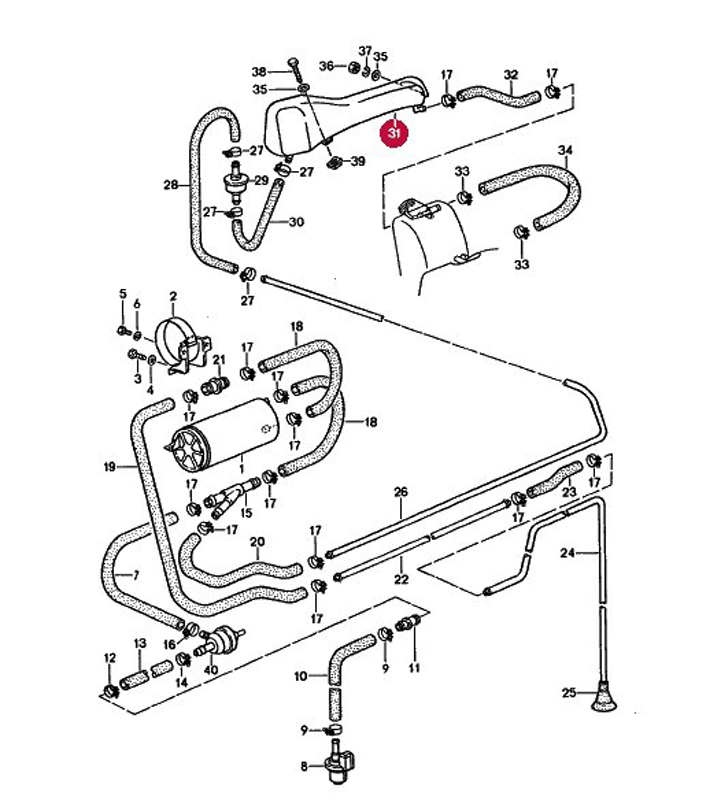

Hose # 34 is for equalizing
pressure between the main body of the tank and the filler neck, so that the tank
can be filled up completely. If that hose is pinched, air is trapped in the main
body of the tank and the tank will not fill to full.
So the problem lies anywhere forward of hose # 32. The venting lines run all the
way forward to the charcoal cannister and engine, and back towards the rear of
the car. Part #25 is the air inlet for the venting system and sits in the middle
under the rear bumper. Thus, you have to trace the venting system from hose #32
to part #25 to find where it is blocked (or start at #25 )
In my case when I replaced the charcoal cannister, I replaced the hard preformed
hoses #18 with new flexible ones but made the radius too tight.
Did you experience air rushing into the tank when releasing the gas cap btw?
Nice tremble at 0:15
And yeah, how did you manage to get the drop link like that??
Edit: I suppose hose #34 could cause the tank to implode as well since the
filler neck end really low on the main body of the tank. I remember I found the
pinched hose on my car by loosening each hose consecutively and blowing through
air inlet #25. When the system was blocked, couldn't force air through it. When
I loosened the culprit, it was easy to blow through. That is, with the gas cap
removed.
__________________
Aryan
===
Car's back together but I'm not sure I cured anything. Spent some time sussing
out the connections everywhere. This is what I checked:
-Blew compressed air (5 psi) into the vent hose behind the fuel tank- blew clear
to the 'luft' connection on the front of the carbon canister.
-With the gas cap off, I blew compressed air into the vent hose on the 'tank'
connection at the carbon canister- could see fuel vapors being pushed out of the
filler neck.
-I checked the diaphragm in the vacuum valve near the filler neck- It held
vacuum just fine.
-None of the hoses to the carbon canister or any hoses in the engine compartment
between the vacuum valve and the intake mainfold are kinked in any way.
-The vacuum lines to the vacuum valve and the diverter valve are identical
between the GT and the GTS, so I don't think that's an issue.
-The three connections on the carbon canister all communicate with one another,
can blow air into any one and feel air at the other two. The old canister
weighed 2lbs 10oz. I happened to have a new one, and it was 2 lbs 5 oz, so I
installed it. (It behaved identically to the old one, all connections were in
communication with each other)
So I guess I'll fill the tank and check it every 10 miles for a while to make
sure I'm not re-imploding the tank. I never did identify why this was happening.
Even if there was a malfunction with the solenoid-operated bleeder valve so it
was open to engine vacuum all the time, as long as the charcoal canister is open
to atmosphere thru the vent, it shouldn't matter.
I must have pinched the tank equalization hose the first time I reinstalled the
tank, nothing else makes sense to me....
For posterity I made some fuel/vent diagrams 'cause I couldn't keep the whole
thing in my head at once.
From the back to the front:
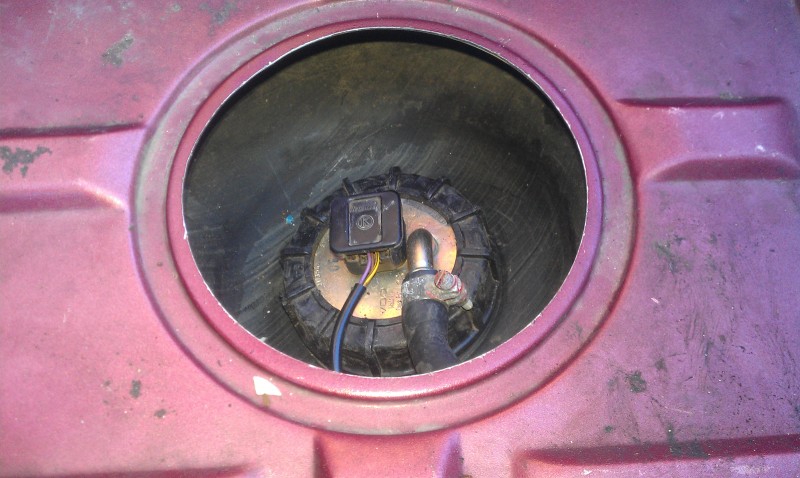
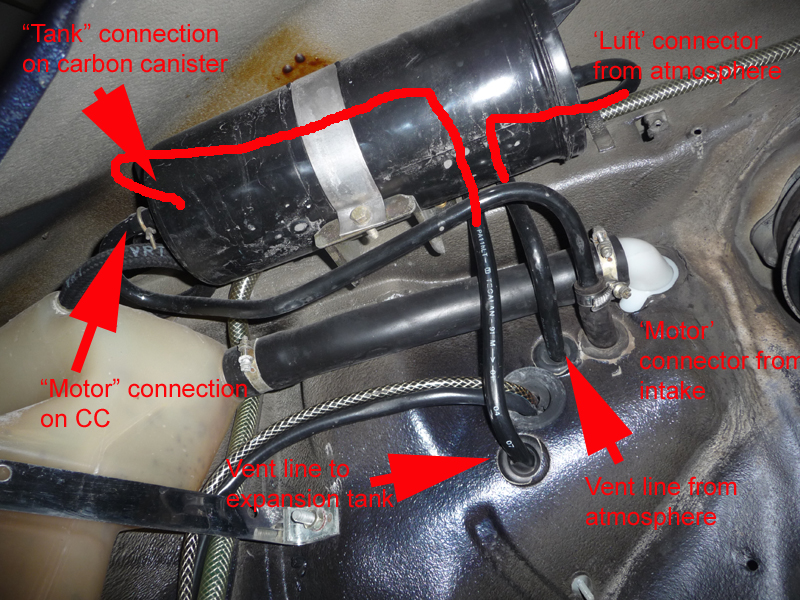
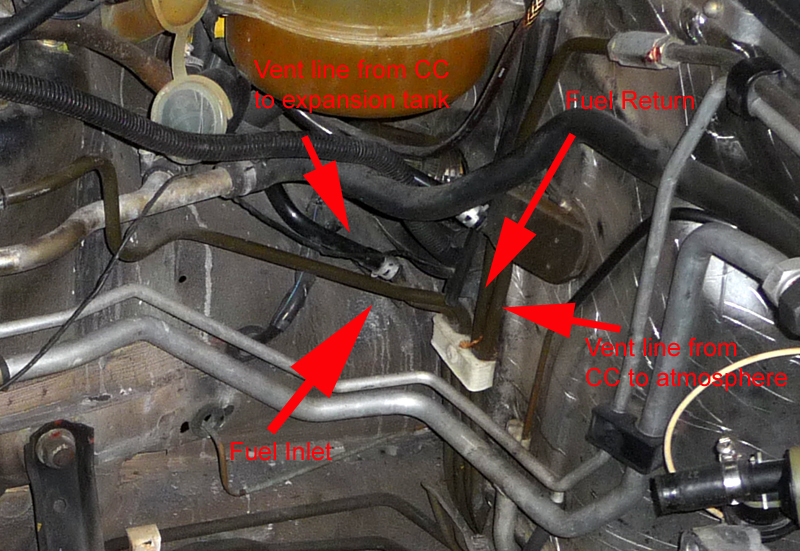


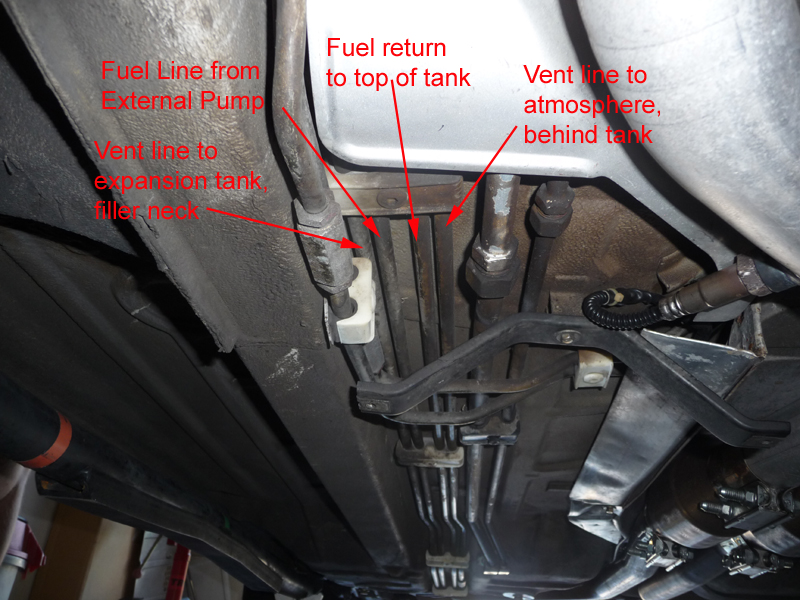

****** pictures
====
Was looking for something else and came across this in the '87 service info. It
describes the operation of the diaphragm valve and the solenoid valve for
metering fuel vapor back to the intake. If I'm reading it correctly, it seems to
me that if the solenoid valve doesn't receive power, it opens. I wonder then if
it fails in the open position (and the diaphragm valve is open any time there's
intake vacuum), would the entire fuel tank vent system be directly connected to
intake vacuum anytime the engine's running? And if so, might that not collapse
the tank while, say, hooning around with one's new stroker motor?
Guess I could hook up my spanner and see if the solenoid is good...

====
FWIW Rob, My car was fine as long as I was driving around town, and local
freeway driving. My tank got sucked in while I was on my road trip. Thats when
the sender started giving erratic readings. When the car sat the gauge would go
to what ever level the fuel was in the tank, till I got on the road and drove at
a sustained speed for an hour or more then the gauge would slowly move up to the
full mark. I'm waiting on some parts and havn't gotten a chance to pull my right
front fender liner and start blowing out the lines. I'll post my findings over
this weekend.
As a side note Greg Nettles has a customers car thats is doing the same as ours.
He said that he would post whatever he finds out as well.
Here's what I found. I pulled the right front fender liner to get to the carbon
cannister. When I got the cannister down where I could look at it, I found that
the PO, or someone he paid to fix the "Y" at the cannister, used soft plastic
tubing instead of reinforced fuel line. This cheap crap collapsed, and caused my
gas tank to collapse, cause there was no way to vent the system. I took my
compresior and blew out the vent line while everything was apart. It was clear.
I put in a new sender in the tank and replaced all the soft rubber lines while I
was looking for the problem. I'm lucky I have small hands, I reached down into
the gas tank and put the cover ring back on the baffel. The lip on the bung for
the tank is sharp as a razor, ask me how I know. My car doesn't have the inside
tank pump only the screen. Put 12 gallons of fuel in, and the gauge is working,
it registered almost a half tank of fuel. Not sure if it's accurate. Better than
full all the time.
__________________
Polecat702 87 928 S4
====
On Tuesday I drove the 15 miles or so to Greg's shop and by the time I got there,
the damn tank had re-collapsed a little (should have just unscrewed the gas cap....)
Anyway, I threw in the towel and asked Greg to fix it. He re-reinflated the
tank, and found that the tank vent solenoid valve was open all the time,
regardless of 12V to it or not. So he put in a good one and after we drove
around a good bit today the tank did not collapse. Why this fixed it I do not
know, but as long as it stays fixed, I'm happy.....
__________________
Rob Edwards
====
Good to know. It is my understanding that the solenoid valve opens under
specific conditions, e.g. at start up, but then it closes again. When it is open
continuously there is vacuum on the tank all the time. Great that things are
working again the way they should
__________________
Aryan